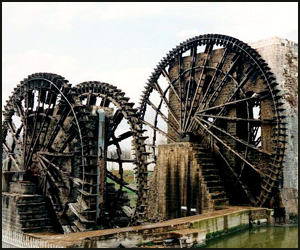Aftermaths of Islamic Farming
The decline of Islamic farming,
just as other aspects of Islamic civilisation, as the last part
of this work will abundantly show, began with the many invaders
of the Islamic world, from the Banu Hillal in North Africa
(1057), to the Crusaders
(1095-1291) to the Mongols (13th century), Timur Lang
(late 14th century), and so on. These invasions
destroyed crops and orchards, closed down trade routes,
destroyed irrigation and water supply, and caused farmers to
take flight.[1]
Everywhere the Muslims fell under the Christian foe, from being
land owners, they were made into slaves or serfs tied to the
estates of their new masters.
In
the East (the Holy Land and
When, eventually, the Muslims were wiped out in
both Christian Spain and
‘Were never able to do justice to the rich soil of
The particular instance of the sugar industry serves to
illustrate this very well. The industry reached its peak in the
14th century in the still Islamic parts of
‘In proportion as the Moriscos left our soil, so began a great
decadence in sugar production, which continued to fall rapidly
for this reason, and for others, which there is no reason to
mention here. Motril alone between the 16th and 18th
centuries lost many mills, and at the beginning of the 19th
century there did not remain in
Devastated by the medieval invaders, fallen under new Christian
rule, the Islamic farming legacy was finished off by modern
Western colonisation. This final intrusion, which began in the
18th century, seriously upset the traditional
agricultural balance in order to increase profitability for the
colonisers.[11]
Wolf explains how the
victory of the East India
Company (1750s and
after) over the Mughals gave it and its officials the means to
subordinate Indian resources for ‘the process of accumulation in
the home country,’ thus siphoning wealth out of country, and
impoverishing the local industry.[12]
Wolf
also expands on the effects the Dutch had on their most prized
possessions in the southern seas, the
In
[1]
See final chapter in A. Watson: ‘Agriculture in
retreat,’ in A. Watson: Agricultural, op cit.
[2]
Ibid; Note
20; p. 211.
[3]
T. Glick: Irrigation and Society in Medieval
[4]
A. Watson: Agricultural; op cit; Note 21; p.211.
[5]
See H.C. Lea: A History of the Inquisition
;
op cit; volume three, pp 317-410.
[6]
S.P. Scott: History; op cit;
vol 2; p. 615.
[7]
S. Lane Poole: The Moors; op cit; p. 275.
[8]
Balaguar y Primo: Cultivo de la Cana de Azucar
(Madrid; 1877), pp. 28 and seq.
[9]
N. Deerr: The History; op cit; p. 81.
[10]
Balaguar y Primo: Cultivo de la Cana; op cit; pp.
28 and seq.
[11]
L. Bolens: Agriculture, in Encyclopaedia (Selin
ed), op cit, p. 22.
[12]
E. Wolf:
[13]
Ibid.
[14]
W. Howitt: Colonisation and Christianity
(Longman; London; 1838), pp. 256 ff.
[15]
E. Wolf:
[16]
Good accounts of such French devastation can be found in
the following:
-C.R. Ageron: Histoire de l’Algerie contemporaine,
3 vols (Presses Universitaires de France, 1979).
-C.A. Julien: Histoire de l’Algerie Contemporaine
(Presses Universitaires de France, 1964).
-H. Alleg et al: La Guerre d’Algerie (Temps
Actuels, Paris, 1981). |
